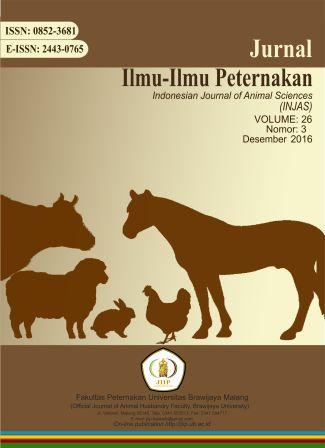Pengaruh penggunaan limbah industri jamu dan bakteri asam laktat (Lactobacillus sp.) sebagai sinbiotik untuk aditif pakan terhadap performans ayam petelur periode layer
DOI:
https://doi.org/10.21776/ub.jiip.2016.026.03.02Abstract
This study aimed to determine the level of feed consumption, egg production, feed conversion ratio (FCR), and the income over feed cost (IOFC) of layers at CV. Popular Farm, Kendal, Semarang. The study used 100 laying hens aged 40 weeks with average body weight 1,815 ± 0.12 g (CV = 6.65%). Feed compositions used for this research were corn flour, bran, premix, soy, meat bone meal and given additional sinbiotik). Experiments at-designed with a completely randomized design (CRD) with 4 treatments and 5 replications. There were 20 units and each unit consists of 5 laying hens. Giving sinbiotic given as 0%, 0.5%, 1%, and 1.5% in the feed. Sinbiotik gave effect at level of 0.5-1% (P<0.05) to reduce the number of intake and feed conversion ratio. Best treatment combination with the performance of chicken layer with a level of 0.5% with the results better of income over feed cost.
Â
Keywords: chicken layer, prebiotics, probiotics, sinbiotik, feed consumptionDownloads
Published
How to Cite
Issue
Section
License
Authors who publish with this journal agree to the following terms:- Authors retain copyright and grant the journal right of first publication with the work simultaneously licensed under a Creative Commons Attribution License that allows others to share the work with an acknowledgment of the work's authorship and initial publication in this journal.
- Authors are able to enter into separate, additional contractual arrangements for the non-exclusive distribution of the journal's published version of the work (e.g., post it to an institutional repository or publish it in a book), with an acknowledgment of its initial publication in this journal.
- Authors are permitted and encouraged to post their work online (e.g., in institutional repositories or on their website) prior to and during the submission process, as it can lead to productive exchanges, as well as earlier and greater citation of published work (See The Effect of Open Access).
















